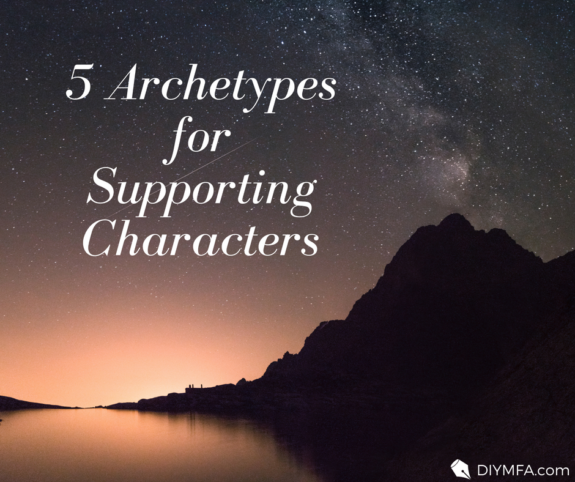Before we get to the discussion of character archetypes, I’d like to make a request: please strike the term “secondary character” from your vocabulary. Not only does it imply that somehow these characters are less important than the protagonist, but the term itself doesn’t tell us much about the role these characters play in the story. The term “supporting character” makes much more sense to me because it underscores the reason why these characters exist.
Supporting characters exist for one reason only: to add depth to the protagonist.
Now don’t you all jump up and start protesting that supporting characters are much more than just a support for the main character. Let me explain. In the confines of the story, supporting characters exist for the sole purpose of interacting or otherwise engaging with the protagonist. Supporting characters might be multifaceted but they are still supporting characters. They exist so they can do things in the story that will affect the protagonist and thus allow us to better understand that main character.
But just because a character is “supporting” doesn’t make him or her “secondary” to the protagonist. In the original Star Wars trilogy for example, Darth Vader is far more interesting and complex than Luke Skywalker, despite being the “supporting” character. The purpose of the supporting character is to help us better understand the main character, but that doesn’t mean the supporting character is any less important.
That said, there are many different types of supporting characters. I’ve chosen five archetypes and will give you a quick run-down of who these characters are and why they exist in the story.
The Nemesis
Also known as the “villain,” the nemesis is at odds with the protagonist and creates conflict from the get-go. Whether this conflict is big “good vs. evil” stuff or simply a scuffle between the unpopular protagonist and the mean cheerleader, the purpose of the nemesis is to create conflict for the protagonist.
Examples: Darth Vader (original Star Wars trilogy), Voldemort (Harry Potter series), Regina (Mean Girls).
For more details on the role of villains and antagonists in a story, click here.
The BFF / Sidekick
Just because this is the main character’s best friend, doesn’t mean there’s no conflict. In almost every protagonist-BFF relationship, there ends up being some sort of falling out part-way through the story that causes additional conflict for the main character. Look at Harry, Ron and Hermione in the Harry Potter series. It seems like two of the three are always fighting and the only thing that changes is which two happen to be getting along at any given moment in the story.
Examples: Ron and Hermione (Harry Potter books), Goose (Top Gun), Murtaugh (Danny Glover’s character in the Letal Weapon movies), Dion (Cher’s BFF in Clueless).
The Mentor
This character exists to advise the main character and pass on valuable information. Interestingly enough, the information that the mentor usually shares is intended just as much for the reader (or audience) as for the main character. For example, whenever Dumbledore gives Harry Potter one of his end-of-the-book monologues, he’s imparting valuable information that not only Harry needs to know but the reader as well.
Examples: Obi Wan Kenobi (Star Wars movies), Dumbledore (Harry Potter series).
The Love Interest
This is the Peeta to the protagonist’s Katniss (The Hunger Games trilogy), the Juliet to the main character’s Romeo, the Princess Leia to his Han Solo, the Harry to her Sally. Note that just because one member of the lover pair might love the other, it doesn’t mean the other returns that love. After all, unrequited love is one of the greatest sources of conflict for a story.
The Fool
In Shakespearean terms, the fool is a character (usually the court jester) who says the things that the protagonist may not want to hear but needs to hear. Just because the fool is called “The Fool” doesn’t mean he or she is foolish. In many cases, the fool may be the wisest character of the bunch, sharing pearls of wisdom with the rest of the characters, only no one seems to listen.
Examples: The Fool (King Lear), Haymitch (The Hunger Games trilogy), Alan Arkin’s character (the grandfather) in Little Miss Sunshine.
This list is by no means exhaustive, but you’ll find that most supporting characters will fall into one of these five categories.







